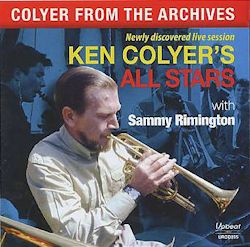1. Dinah
2. Climax Rag
3. St. James Infirmary
4. Milenberg Joys
5. Mahogany Hall Stomp
6. You Always Hurt the One You Love
7. Tell Me Your Dream
8. Riverside Blues
9. Sing On
10. Blame It on the Blues
11. Oh, Lady Be Good
12. The Girls Go Crazy
Ken Colyer – Cornet, vocal (tracks 1 and 3)
Sammy Rimington – Clarinet
Mike Pointon – Trombone
Bill Stotesbury – Banjo
Annie Hawkins – String bass
Colin Bowden – Drums
Recorded live on a cruise from Westminster Pier, London, on Sept. 6, 1973.
This recent release by Upbeat will bring joy to the hearts (and ears) of the coterie of Ken Colyer fans. It consists of previously unissued material from
some 40-odd years ago and, although recorded at a Thames riverboat event most probably by some non-professional, the sound is surprisingly good, thanks in
large part most likely to the ministrations of Messrs. George Crump and Glenn Mitchell, who handled the transfers. A few tracks are missing the first note
or two, due to late starting of the tape recorder, I would imagine, but that is a minor flaw, as is a slight imbalance in the sound, which is to be
expected of a live recording.
One of the advantages of a non-studio recording is that there is an audience present, and the synergy that can develop between band and audience can lift
the band to another level. The energy that the band displays on this recording is indicative of such communication, although since almost every track
quickly cuts off as soon as the tune ends, it is difficult to assess exactly the audience response. But there is no mistaking the exuberance of the
playing, to which surely the audience contributed, coupled with the shouts of encouragement and approbation to be heard on various tracks
All of the songs in this playlist have been done elsewhere many times by Colyer, but each version always is fresh. Changes in personnel account for this in
part, but there is no mistaking Colyer’s part as he marshals his troops in the direction he wants. The collective improvisation of the ensembles is
stressed. While individuals do take solos, they tend to have only the first chorus to themselves, the rest of the front line joining in with riffs to
support successive choruses. This, coupled with multiple ensembles—especially leading up to codas—and judicious use of dynamics, builds an excitement which
engages both musicians and audience alike.
This is apparent on the first track, Dinah, and the others that follow are no different. Climax Rag opens in rather leisurely fashion
with interesting variations by Colyer on the breaks. When Rimington takes the lead, it is in the bottom register—a rich, full bodied tone—followed by his
working up through the middle and upper registers. In turn, Colyer plays some delightful little chromatic runs on his turn at lead. After the solos, there
are several choruses all building in intensity—but not volume—leading into the coda.
Each of the selections has its own moments. St. James Infirmary includes Rimington exploring the entire range of his instrument with great
flurries of notes; Colyer illustrating the manner vibrato can enhance the blues (as he does again on Riverside Blues); and Bowden underscoring the
funereal component with the pressed rolls on a muffled snare. One could go on to deconstruct each cut, but that would be to deprive the listener of that
pleasure.
This is all pure Colyer, even though some two years earlier he had some serious health issues and had to give up leading his band. There is no hint of any
difficulty here—his playing is as strong as ever. The cast around him is stellar. On the one side he has Pointon’s gruff trombone below him and on the
other Rimington’s clarinet below, around, and above him. The rhythm section keeps a fairly steady grip on tempos, only a little rushing being detectable
here and there. Sometimes Bowden gets a little carried away with rather loud tom toms, cymbal crashes, and rim shots. His four-bar tag at the end of Mahogany Hall Stomp seems to catch the others unaware, and a potential train wreck is avoided by Colyer’s adroitly bringing the others in with a
couple of measures leading to a repeat of the last four. But there can be no gainsaying the excitement the ebullient Bowden musters in the back line.
Hawkins’ strong bass plucking is very complementary in this regard, as is Stotesbury’s solid four on banjo. These three provide a solid platform for the
front line to build on. It all adds up to a fine performance.
Undoubtedly there are other private recordings out there of gigs where Colyer heads one or another aggregation. Some may be of sufficiently high quality to
release. This was one such, and fortunately Upbeat chose to make it available. Anyone on that Thursday river outing so long ago will want it, but it
deserves to be on everyone’s Colyer shelf.
Bert Thompson
